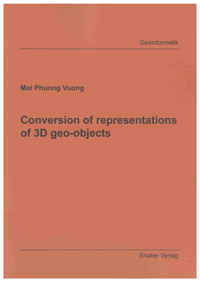
Shop : Details
Shop
Details

March 2012
Mai Phuong Vuong
Conversion of representations of 3D geo-objects
Ever increasingly huge sets of data indexed with reference to 2d, 3d or 4d real space are being collected in all fields of science and require intelligent data models for weil performing management. Thus we experience a growing interest in more efficient data models to describe objects, both in terms of memory and management, especially search and retrieval.
Two features involve modeling objects: geometry and topology. The former gives the description about the location in space, the shape of objects. The latter describes the neighboring relationships between objects, and that between cells (ie. vertices, edges, faces, etc) of objects.
The contributions of this work can be summarized into the following aspects:
Two features involve modeling objects: geometry and topology. The former gives the description about the location in space, the shape of objects. The latter describes the neighboring relationships between objects, and that between cells (ie. vertices, edges, faces, etc) of objects.
The contributions of this work can be summarized into the following aspects:
- Defining the decomposition of objects into cells, and properties of such a decomposition;
- A novel model for modeling the topology of objects given in any spatial dimension;
- An approach for converting objects given in terms of pixel or voxel into boundary representation including topology;
- An application in Materials science to reconstruct grain boundaries from Electron backscatter diffraction data;
Keywords: Geoinformatics; Representation; TMaps; 2D Conversion; 3D Conversion; Grain boundaries; Boundaries extraction
Available online documents for this title
You need Adobe Reader, to view these files. Here you will find a little help and information for downloading the PDF files.
Please note that the online documents cannot be printed or edited.
Please also see further information at: Help and Information.
Please also see further information at: Help and Information.
| Document |  | Abstract | ||
| Type |  | |||
| Costs |  | free | ||
| Action |  | Download the file | ||
| Document |  | Document | ||
| Type |  | |||
| Costs |  | 36,60 € | ||
| Action |  | Purchase in obligation and download the file | ||
| Document |  | Table of contents | ||
| Type |  | |||
| Costs |  | free | ||
| Action |  | Download the file | ||
User settings for registered online customers (online documents)
You can change your address details here and access documents you have already ordered.
User
Not logged in
Export of bibliographic data
Shaker Verlag GmbH
Am Langen Graben 15a
52353 Düren
Germany
Am Langen Graben 15a
52353 Düren
Germany
Mon. - Thurs. 8:00 a.m. to 4:00 p.m.
Fri. 8:00 a.m. to 3:00 p.m.
Fri. 8:00 a.m. to 3:00 p.m.
Contact us. We will be happy to help you.

